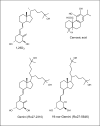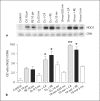Synergistic antileukemic activity of carnosic acid-rich rosemary extract and the 19-nor Gemini vitamin D analogue in a mouse model of systemic acute myeloid leukemia
- PMID: 18852491
- PMCID: PMC2826875
- DOI: 10.1159/000163849
Synergistic antileukemic activity of carnosic acid-rich rosemary extract and the 19-nor Gemini vitamin D analogue in a mouse model of systemic acute myeloid leukemia
Abstract
Objective: Differentiation therapy with the hormonal form of vitamin D, 1alpha,25-dihydroxyvitamin D(3) (1,25D(3)), is a promising approach to treatment of acute myeloid leukemia (AML); however, 1,25D(3) induces hypercalcemia at pharmacologically active doses. We investigated the in vitro and in vivoantileukemic efficacy of combined treatment with non-toxic doses of a low-calcemic 1,25D(3) analogue, 1,25-dihydroxy-21(3-hydroxy-3-methyl-butyl)-19-nor-cholecalciferol (19-nor-Gemini; Ro27-5646), and rosemary plant agents in a mouse model of AML.
Methods: Proliferation and differentiation of WEHI-3B D- (WEHI) murine myelomonocytic leukemia cellsin vitro were determined by standard assays. Reactive oxygen species, glutathione and protein expression levels were measured by flow cytometry, enzymatic assay and Western blotting, respectively. Systemic AML was developed by intravenous injection of WEHI cells in syngeneic Balb/c mice.
Results: 19-nor-Gemini had a higher potency than its parent compounds, Gemini (Ro27-2310) and 1,25D(3), in the induction of differentiation (EC(50) = 0.059 +/- 0.011, 0.275 +/- 0.093 and 0.652 +/- 0.085 nM, respectively) and growth arrest (IC(50) = 0.072 +/- 0.018, 0.165 +/- 0.061 and 0.895 +/- 0.144 nM, respectively) in WEHI cells in vitro, and lower in vivo toxicity. Combined treatment of leukemia-bearing mice with 19-nor-Gemini (injected intraperitoneally) and standardized rosemary extract (mixed with food) resulted in a synergistic increase in survival (from 42.2 +/- 2.5 days in untreated mice to 66.5 +/- 4.2 days, n = 3) and normalization of white blood cell and differential counts. This was consistent with strong cooperative antiproliferative and differentiation effects of low concentrations of 19-nor-Gemini or 1,25D(3) combined with rosemary extract or its major polyphenolic component, carnosic acid, as well as with the antioxidant action of rosemary agents and vitamin D derivatives in WEHI cell cultures.
Conclusion: Combined effectiveness of 1,25D(3) analogues and rosemary agents against mouse AML warrants further exploration of this therapeutic approach in translational models of human leukemia.
Copyright 2008 S. Karger AG, Basel.
Figures







References
-
- Estey E, Dohner H. Acute myeloid leukaemia. Lancet. 2006;368:1894–1907. - PubMed
-
- Eelen G, Gysemans C, Verlinden L, Vanoirbeek E, De Clercq P, Van Haver D, Mathieu C, Bouillon R, Verstuyf A. Mechanism and potential of the growth-inhibitory actions of vitamin D and analogs. Curr Med Chem. 2007;14:1893–1910. - PubMed
-
- Deeb KK, Trump DL, Johnson CS. Vitamin D signalling pathways in cancer: potential for anticancer therapeutics. Nat Rev Cancer. 2007;7:684–700. - PubMed
-
- Trump DL, Muindi J, Fakih M, Yu WD, Johnson CS. Vitamin D compounds: clinical development as cancer therapy and prevention agents. Anticancer Res. 2006;26:2551–2556. - PubMed
-
- Hisatake J, Kubota T, Hisatake Y, Uskokovic M, Tomoyasu S, Koeffler HP. 5,6-trans-16-ene-vitamin D3: a new class of potent inhibitors of proliferation of prostate, breast, and myeloid leukemic cells. Cancer Res. 1999;59:4023–4029. - PubMed
Publication types
MeSH terms
Substances
Grants and funding
LinkOut - more resources
Full Text Sources
Other Literature Sources
Medical

